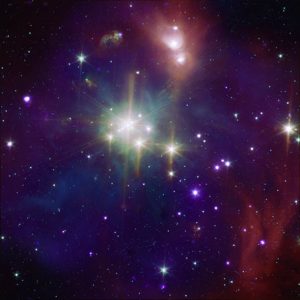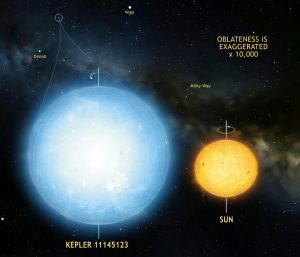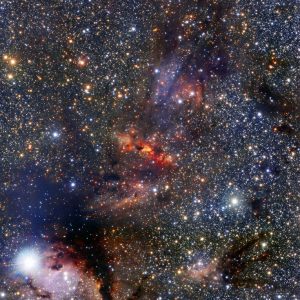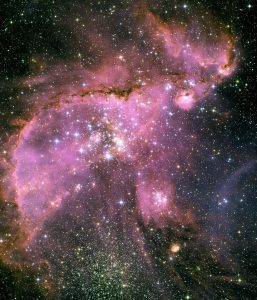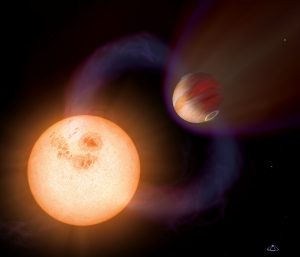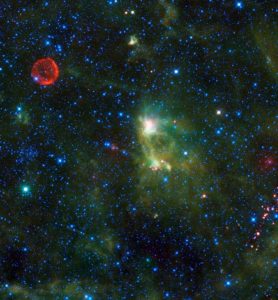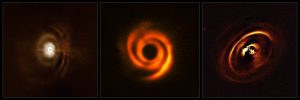stella
Splendore stellare nell’Ammasso Coronet
Anche se forse non è così conosciuta come Orione, la regione della Corona Australe (contenente nel suo cuore l’Ammasso Coronet) è una delle più vicine e più attive zone di formazione stellare. Ad una distanza di circa 420 anni luce, l’ammasso è oltre tre volte più vicino alla Terra di quanto lo sia la nebulosa di Orione. Continua a leggere
La stella più sferica conosciuta
Le stelle non sono sfere perfette. La rotazione causa una distorsione della forma sferica a causa della forza centrifuga. Un team di ricercatori con Laurent Gizon del Max Planck Institute for Solar System Research e l’University of Göttingen è riuscito a misurare lo “schiacciamento” ai poli utilizzando l’astrosismologia. Continua a leggere
Nube a sorpresa
Questa immagine sorprendente mostra una zona della Via Lattea che si trova all’interno della costellazione dello Scorpione, vicino al piano centrale della galassia. La regione ospita una densa nube di gas e polveri associata alla nube molecolare IRAS 16562-3959, ben visibile come macchia arancione in mezzo al ricco raggruppamento di stelle nel centro. Continua a leggere
Giovani stelle creano sculture artistiche
Questa spettacolare immagine ripresa dal telescopio spaziale Hubble rivela i dettagli di una delle regioni di formazione stellare più dinamiche e complesse nello spazio, a 210.000 anni luce di distanza nella Piccola Nube di Magellano, una galassia nelle vicinanze della Via Lattea. Continua a leggere
Un esopianeta a braccetto con la sua stella
Sappiamo che le grandi masse delle stelle governano le orbite dei pianeti che le orbitano, ma può avvenire anche che un grande pianeta in orbita ravvicinata influenzi la rotazione della sua stella. Un gioviano caldo inusuale, recentemente scoperto, influenza la sua stella in modo che ruoti più rapidamente del normale. Continua a leggere
Una stella neonata arde nel firmamento
I filamenti perlacei che circondano la stella IRAS 10082-5647 in questa mirabile immagine del telescopio Hubble attirano sicuramente lo sguardo. La nube fumosa è una nebulosa a riflessione, formata da gas e polveri, che brilla delicatamente per la luce riflessa di stelle nelle vicinanze, in questo caso una stella Ae/Be di Herbig estremamente giovane. Continua a leggere
Una Super-Terra molto vicina
Le nane rosse sono ritenute un tesoro per i cacciatori di esopianeti. In aggiunta a molteplici esopianeti rilevati attorno a stelle come TRAPPIST-1, Gliese 581, Gliese 667C, e Kepler 296, occorre ricordare la notevole scoperta di un pianeta in orbita nella zona abitabile della stella più vicina al Sole, Proxima Centauri. Continua a leggere
Storica bellezza
Il resto di supernova di Tycho (SN 1572), il cerchio rosso visibile nella parte superiore sinistra dell’immagine, è il residuo di un’esplosione stellare così chiamata dal nome dell’astronomo Tycho Brahe, anche se all’epoca non è stata l’unica persona ad osservare e registrare la supernova. Continua a leggere
Una coppia magnifica
Davvero spettacolare l’abbinamento tra la stella Hen 2-427, conosciuta più comunemente come WR 124, e la nebulosa M1-67 che la circonda. Entrambi gli oggetti, ripresi dal telescopio Hubble, si trovano nella costellazione del Sagittario, a circa 15.000 anni luce di distanza. Continua a leggere
Straordinari Dischi Scolpiti da Giovani Pianeti
Nuove, nitide osservazioni hanno rivelato strutture sorprendenti nei dischi di formazione planetaria attorno a giovani stelle. Lo strumento SPHERE, montato sul Very Large Telescope dell’ESO, ha reso possibile osservare le complesse dinamiche di giovani sistemi planetari, incluso un sistema che si sta sviluppando in real-time. Continua a leggere
